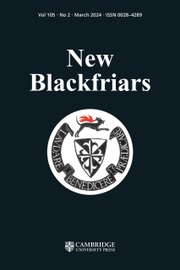No CrossRef data available.
Article contents
Inge, Selwyn, and Gore: 1920s Anglican Responses to Newman’s Development of Doctrine
Published online by Cambridge University Press: 28 July 2025
Abstract
William Inge, Edward Gordon Selwyn, and Charles Gore represent three Anglican responses to John Henry Newman’s Essay on the Development of Doctrine. Development sought to account for doctrinal changes in Christianity by characterising Christianity as a ‘real idea’, expressing an object in the mind that can only be shown in its fullness by encounters with different philosophies over time. This was part of a wider intellectual movement in the 19th century away from static ideas of doctrinal history and towards more dynamic and subjective treatments. Inge, Selwyn, and Gore all make use of Newman after the First World War. Inge argues Newman abstracts historical facts from their realities, and abandons the old concept of tradition, where the church is the custodian of revelation, in favour of a relativistic concept, new in each generation. Selwyn makes use of Newman’s idea to argue for the autonomy of religious experience as a source of human knowledge mediated through religious traditions. Gore argues Newman enables ‘mobility’ in communicating Christianity to different cultures but argues development can be used justify distortions of the first revelation. The test of their authenticity should be whether they are inclusive of those Christ would be inclusive.
Information
- Type
- Article
- Information
- Copyright
- © The Author(s), 2025. Published by Cambridge University Press on behalf of Provincial Council of the English Province of the Order of Preachers.
References
1 Geoffrey Rowell, ‘Anglican Theological Receptions’, in Frederick D. Aquino and Benjamin J. King, ed., The Oxford Handbook of John Henry Newman, (Oxford: Oxford University Press, 2018), p. 519.
2 John Henry Newman, Essay on the Development of Doctrine, 3rd Edition (Notre Dame: Notre Dame Press, 1994), p. 7; hereafter Development.
3 Development, p. 30.
4 Development, p. 29.
5 Development, pp. 15–16.
6 Joshua Bennett, God and Progress (Oxford: Oxford University Press, 2019), pp. 56–70.
7 Development, p. 35.
8 Development, p. 38.
9 Development, p. 55.
10 Development, p. 58.
11 Development, p. 174.
12 Development, p. 186.
13 Development, p. 188.
14 Development, pp. 371–373.
15 Development, pp. 7–8.
16 Development, p. 79.
17 Aidan Nicholls, From Newman to Congar (Edinburgh: T&T Clark, 1990), p. 49.
18 Development, p. 97.
19 John Coulson, Newman and the Common Tradition: A Study in the language of Church and Society (Oxford: Clarendon Press, 1970), p. 61.
20 David Nicholls, ‘Newman’s Anglican Critics’, Anglican Theological Review 47 (1965), pp. 377–95; Benjamin King, ‘The Protestant Reception of the Essay on Development, 1845-1925’ in Frederick D. Aquino and Benjamin J. King, ed., Receptions of Newman (Oxford: Oxford University Press, 2015), pp. 9–20.
21 For Faber, see Frank Turner, John Henry Newman: The Challenge to Evangelical Religion (New Haven, Yale University Press, 2002), p. 578; for Moberly see Nicholls, ‘Anglican Critics’, p. 381; for Hampden, see King, ‘Protestant Reception’, p. 12, 16.
22 Bennett, God and Progress, pp. 72–73.
23 F.D. Maurice. The Epistle to the Hebrews (London: J W Parker, 1846), p. xxiii.
24 Ibid, p. xxv.
25 J B Mozley, The Theory of Development: A Criticism of Dr Newman’s Essay on the Development of Christian Doctrine (London: Rivingtons, 1878) p. 147.
26 Ibid, p. 149.
27 Adrian Hastings, A History of English Christianity 1920-1985 (London: Collins, 1986), pp. 176–177.
28 Bennett, God and Progress, p. 41.
29 Ibid, pp. 240–241.
30 William Inge, Outspoken Essays, Second Series (London: Longmans, Green & co, 1922), p. 162.
31 Ibid, p. 161.
32 William Inge, Outspoken Essays, First Series (London: Longmans, Green & co, 1920), pp. 143-144.
33 Ibid, pp. 144.
34 Ibid, p. 145.
35 Ibid, p. 145.
36 Oliver Quick, Liberalism, Modernity and Tradition: The Bishop Paddock Lectures (London: Longmans, Green & Co, 1922), p. 27.
37 Ibid, p. 163; for other unexpected alliances in the 1920s, see King, ‘Protestant Receptions’, pp. 24–28.
38 Ibid.
39 Ibid, p. 164.
40 Ibid, p. 165.
41 Ibid, pp. 182–184.
42 Ibid, p. 185.
43 Ibid, p. 189–190.
44 Ibid, p. 191.
45 Ibid, pp. 181–182.
46 Gordon Selwyn, An Approach to Christianity (London: Longmans, Green and Co, 1925) p. 15.
47 Ibid, p. 26.
48 Michael Ramsey saw Essays Catholic and Critical as the most important monument of interwar liberal catholicism. Michael Ramsey, From Gore to Temple (London: Longmans, 1960) p. 102.
49 Ibid, p. 41.
50 Ibid.
51 Ibid, p. 47.
52 Development, p. 23.
53 Ibid, p. 238.
54 Ibid, pp. 238–241.
55 See G.L. Prestige, The Life of Charles Gore (London: Heinemann, 1935), pp. 420–422 and Peter Waddell, ‘Introduction’, in Peter Waddell, ed., Charles Gore: Prophet and Pastor (Norwich: Canterbury, 2014), p. xxv.
56 Waddell, ‘Introduction’, p. xxv.
57 Charles Gore, Holy Spirit and the Church (London: Charles Scribner’s Sons, 1924), Preface, pp. v–x.
58 Ibid, p. 161.
59 Ibid, p. 164.
60 Ibid, pp. 171–177.
61 Ibid, p. 174.
62 Ibid, p. 208.
63 Ibid, p. 209.
64 Unlike Inge, who sees Newman as echoing Schleiermacher, Gore correctly identifies Newman’s Roman Catholic contemporaries Petavius and Möhler as his immediate predecessors.
65 Development of Doctrine, p. 116 in the 1845 edition, which Gore cites.
66 Charles Gore, Holy Spirit and the Church (London: Charles Scribner’s Sons, 1924), p. 213.
67 Ibid, pp. 213–214.
68 Paul Avis, Gore: Construction and Conflict (Worthing: Churchman Publishing Limited, 1988), p. 32.
69 Ibid, pp. 214–215.
70 Ibid, p. 218.
71 Ibid, p. 219.
72 Ibid, p. 220.
73 Ibid, pp. 220–221.
74 Ibid, p. 221.
75 Ibid, pp. 222–223.
76 King, ‘Protestant Receptions’, pp. 27–28.
77 Prestige, Charles Gore, p. 22.
78 Gore, The Church and the Holy Spirit, pp. 208–209.
79 Ibid, 214; Gore, Incarnation, p. 253.
80 c.f. Charles Gore, The Incarnation of the Son of God (London: John Murray, 1891), pp. 102–106.
81 Ibid, p. 227.


